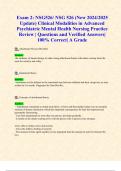Exam (elaborations)
PEARSON EDEXCEL GCE A-LEVEL CHEMISTRY 6CH05/01 ADVANCED UNIT 5 GENERAL PRINCIPLES OF CHEMISTRY 2 TRANSITION METALS AND ORGANIC NITROGEN CHEMISTRY [including synoptic assessment] (AUTHENTIC MARKING SCHEME ATTACHED)
- Module
- ORGANIC CHEMISTRY
- Institution
- PEARSON (PEARSON)
PEARSON EDEXCEL GCE A-LEVEL CHEMISTRY 6CH05/01 ADVANCED UNIT 5 GENERAL PRINCIPLES OF CHEMISTRY 2 TRANSITION METALS AND ORGANIC NITROGEN CHEMISTRY [including synoptic assessment] (AUTHENTIC MARKING SCHEME ATTACHED)
[Show more]












